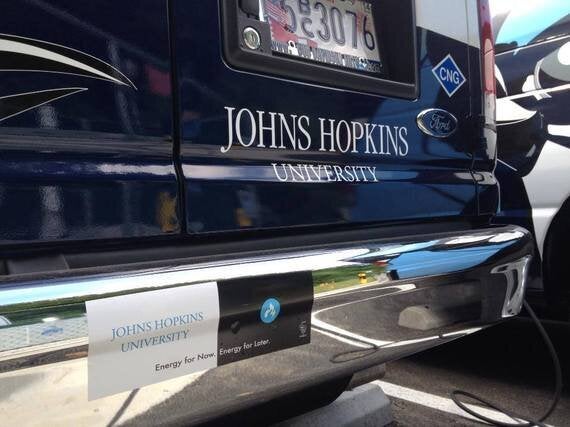
"This project is never going to happen," was the first thing that the Johns Hopkins' parking manager told me. "Maybe it can be your graduate thesis!" he continued, smiling. In 2011 I returned from my first One Young World (OYW) Summit driven to find a project that would show that sustainability is not a zero-sum game. Or in the words of Bob Geldof to I wanted to "get on with it." I formed the first-ever Student Government (SGA) Sustainability Committee as a first step.
Working with my committee, I identified the Blue Jay Shuttle service as the best target for our initial project. The shuttle fleet comprises ten Ford E-350s that transport students at night around campus on fixed routes. During six months of research and investigation, I calculated that a transition from gasoline to natural gas could save 750,000lbs+of CO2 while paying for itself in less than seven years and having a ten-year internal return rate of 16.1%. Though intrigued, the parking manager insisted that the reliability or capability of his fleet must not be compromised. I then worked with the Maryland Energy Administration to obtain grants and Ford Motor Company to ensure that a transition to natural gas would maintain full functionality of the vehicles.
My work led to a pitch to the deans of finance in December 2011, who remained doubtful and even a bit dismissive. Temporarily disillusioned by the setback, I decided to redouble my efforts, taking my proposal to more and more people and pitching the project whenever I had a chance. I mobilized the SGA to increase student involvement and worked with all of the key players to refine and strengthen the project.
But before I made the pitch again, I wanted a little more support. I heard of a sustainability video contest put on by the White House Council for Environmental Quality (CEQ). In the middle of finals week a couple of friends and I set out to make a three minute short video on the project and how it fits into the broader concept of sustainability. To our surprise, the video (https://www.youtube.com/watch?v=MUcFg7tsv7Y) won and we were invited to the White House to meet with officials from the CEQ (http://goo.gl/iJyTKC).
I now felt that my project was getting the attention it deserved. This tenacity and persistence proved to be invaluable, as I eventually landed the opportunity to make a pitch to the JHU President, Ron Daniels. He agreed to nothing at the time, but behind the scenes he followed up with the main stakeholders and learned that I had left no stone unturned. A month later, President Daniels announced full financial backing for the project. Two fulfilling years later the project is complete, the vehicles are running and the school is looking to expand the fleet.
Fleet managers at universities are in a unique position to affect positive change in transportation they control both the vehicles and fueling centers whereby solving the "chicken and egg" problem of transportation development. With 4000 colleges serving 20 million students, the progressive market and scale is already organized to create the foundation for a geographically diverse fueling network. It if for this reason that my friends and I have founded the University and College Partnership for Efficient Transportation or UCPET (http://www.ucpet.org/) to advocate for a change in powertrains on college campuses. Whether it be natural gas, propane, or electric, creating a diverse fueling network will be crucial to fighting climate change and moving the future.
After returning from my third OYW conference in Johannesburg, South Africa, I am more inspired than ever to continue the push for sustainability in all aspects of life. I believe sustainability is an activity in which everyone can take part and every party wins; without it, everyone loses. The future is in our hands and One Young World Ambassadors are doing something about it, are you?